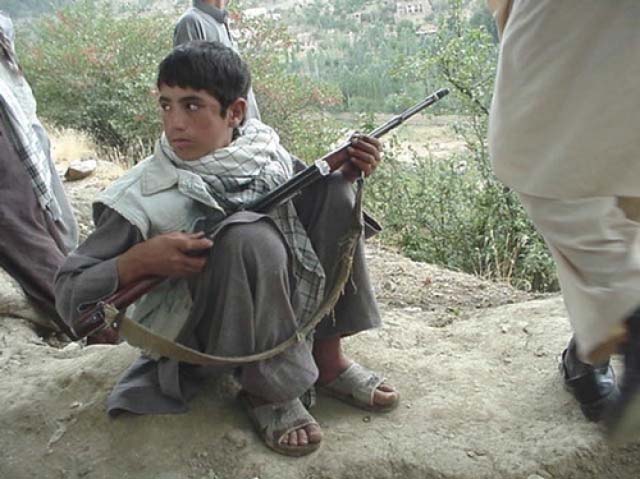The rights and dignity of Afghan children have been violated to a great extent and they took the brunt of violence and terror within the past decade. Scores of children were changed into sacrificial lambs by warring factions, mainly the Taliban and the self-styled Islamic State (IS) group. They had to accept the warped mind of radical groups with the barrel of gun and used as vehicles in battlefields by the armed insurgents – this is the Taliban’s current mainstream. It seems that only the immature minds of naïve children are ripe for their radical ideology. Therefore, they succumb to the Taliban’s heavenly allure inculcated in them or simply threatened to death.
On the one hand, a number of children are armed and sent to battlefields to carry out “jihad” on the other hand, however, they are targeted in terrorist attacks and suicide bombings on streets, on the way to schools, mosques, etc. which is a flagrant violation of national and international laws. So, their blood is spilt from both sides and they are the most vulnerable part of the society.
The Working Group on Children and Armed Conflict, which released a report about Afghan children in 2015, expressed grave concern over the deteriorating situation of children affected by the conflict in Afghanistan, mainly the significant increase in child casualties, continued recruitment of children in violation of applicable international law, as well as attacks on hospitals, schools, and the military use of schools, particularly affecting girls’ education, by all parties to the conflict.
Moreover, the Permanent Representative of Afghanistan reiterated the strong commitment of the Afghan Government to protect the rights of children and briefed the Working Group on major steps taken towards that end. He also described the challenges faced in addressing the violations and abuses against children by anti-state armed groups.
It is a bitter pill to swallow that a number of children were killed and maimed as a result of hostilities between parties to the conflict, explosive remnants of war and the continued used of improvised explosive devices. Although the indiscriminate uses of weapons are prohibited under international humanitarian law, civilians are widely targeted by indiscriminate use of arms.
Moreover, a number of children fall victim to abduction by some parties to the conflict for various purposes, including revenge and ransom, and some of the abducted children suffer atrocities which involve recruitment, killing and maiming, rape and honor-killing.
Between September 2010 and December 2014, Afghanistan suffered heavily. 2014 was a highly significant year as the international community was preparing to withdraw its forces, the Afghan Security and Defense Forces assumed full responsibility for providing security all over the country. Since then, the armed groups intensified their attacks and acts of terror. Joined by thousands of foreign militants, they increased ground engagements and attacks on homes, markets, schools, mosques and critical infrastructures. The unmitigated attacks resulted in the deaths and injuries of more than 10,000 civilians in 2014, with a 48 per cent increase in child casualties, and militancy continues unabated.
An entire generation of children has grown up amid the conflict in Afghanistan. The violence in Afghanistan has led to a high vulnerability of the children. Warring factions, mainly the Taliban, seek to hinder children’s access to education through attacking schools, teaching staff and students, particularly girls and women. The militants use children for multiple purposes such as informers, spies, human shields, foot soldiers, active combatants and even suicide bombers. They prefer children for being readily available, cheap and useful, can be manipulated and terrorized and are often willing to accept the most dangerous assignments because they lack a full understanding of their own mortality. These violent attacks, coupled with poverty and unemployment, lead to children often trying to join the security forces by falsifying their age and identification.
In spite of the Taliban’s claims that they recruit fighters who have achieved “mental and physical maturity,” and do not use underage boys in military operations, some of the children recruited from seminaries in Kunduz, Takhar, and Badakhshan provinces are 13 or younger. The Taliban have previously denied “the use of children and adolescents in Jihadic Operations,” but its deployment of individuals under the age of 18 violates international law applicable in Afghanistan and in cases involving children under 15 is a war crime.
It is worth saying that the government has also taken effective steps to decrease children’s mortality. As a result, the government enacted a law prohibiting underage recruitment in security forces. It also developed unified verification guidelines for all security institutions to prevent underage recruitment. Therefore, hundreds of underage applicants attempting to enlist in security forces were rejected in 2014. The government has also included children’s rights in the curriculum of the security forces, which is a very significant step to educate and sensitize the army and the police about the children’s inalienable rights.
Home » Opinion » Children – The Scapegoat of Terror
Children – The Scapegoat of Terror
| Hujjatullah Zia

